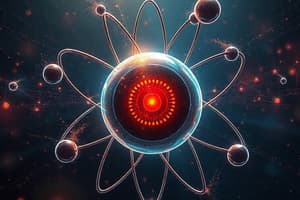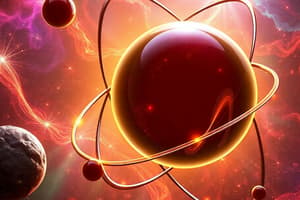Podcast
Questions and Answers
According to the Aufbau Principle, how do electrons in an atom occupy energy levels?
According to the Aufbau Principle, how do electrons in an atom occupy energy levels?
- By occupying the lowest possible energy levels (correct)
- By occupying the energy levels based on their atomic mass
- By occupying the highest possible energy levels
- By filling the energy levels randomly
Which principle states that no more than 2 electrons can occupy the same orbital and that they must have opposite spins?
Which principle states that no more than 2 electrons can occupy the same orbital and that they must have opposite spins?
- Aufbau Principle
- Mendeleev's Rule
- Hund’s Rule
- Pauli’s Exclusion Principle (correct)
Who proposed that elements' symbols should be named by their Latin name or initials?
Who proposed that elements' symbols should be named by their Latin name or initials?
- Dmitri Mendeleev
- John Dalton
- Henry Moseley
- John's Jakob Berzelius (correct)
What type of bond involves the complete transfer of electrons from one atom to another?
What type of bond involves the complete transfer of electrons from one atom to another?
According to the Periodic Table, how are elements arranged based on their similarity?
According to the Periodic Table, how are elements arranged based on their similarity?
In Lewis dot structure, what does the number of valence electrons determine?
In Lewis dot structure, what does the number of valence electrons determine?
What property represents the ability to remove electrons from a neutral gaseous atom to attain stability?
What property represents the ability to remove electrons from a neutral gaseous atom to attain stability?
Which method to attain stability involves two non-metals sharing electrons?
Which method to attain stability involves two non-metals sharing electrons?
What term refers to elements that can exist in two or more different forms?
What term refers to elements that can exist in two or more different forms?
What is the theoretical ability of silicon based on the text?
What is the theoretical ability of silicon based on the text?
Who is credited with formulating the Dalton's Atomic Theory?
Who is credited with formulating the Dalton's Atomic Theory?
Which scientist conducted the 'Gold Foil Experiment'?
Which scientist conducted the 'Gold Foil Experiment'?
According to Bohr's model, what is the fixed path on which electrons revolve called?
According to Bohr's model, what is the fixed path on which electrons revolve called?
Which scientist is associated with the development of the Quantum Mechanical Model?
Which scientist is associated with the development of the Quantum Mechanical Model?
What does the Principal Quantum Number represent in an atom?
What does the Principal Quantum Number represent in an atom?
Which type of orbital has a sharp spherical shape?
Which type of orbital has a sharp spherical shape?
What does the Magnetic Quantum Number describe about an electron?
What does the Magnetic Quantum Number describe about an electron?
What does the Spin Quantum Number indicate about an electron?
What does the Spin Quantum Number indicate about an electron?
In terms of electron configuration, what does 's=2' signify?
In terms of electron configuration, what does 's=2' signify?
Flashcards are hidden until you start studying
Study Notes
Electron Configuration and Principles
- The Aufbau Principle dictates that electrons occupy energy levels starting from the lowest energy level to higher levels.
- The Pauli Exclusion Principle states that no more than 2 electrons can occupy the same orbital, and they must have opposite spins.
Chemical Bonding
- Ionic bonds involve the complete transfer of electrons from one atom to another.
- Covalent bonds involve sharing electrons between two non-metals to achieve stability.
Periodic Table Organization
- Elements in the Periodic Table are arranged based on their similarity in chemical properties, following trends across periods and groups.
Valence Electrons and Lewis Dot Structures
- In Lewis dot structures, the number of valence electrons determines the number of dots representing the electrons around an element's symbol.
Atomic Stability and Ionization
- Ionization energy represents the ability to remove electrons from a neutral gaseous atom to attain stability.
Allotropes and Element Symbols
- Elements that can exist in two or more different forms are referred to as allotropes.
- The system for naming chemical symbols based on Latin names or initials was proposed by J.J. Berzelius.
Theoretical Concepts in Chemistry
- Silicon has a theoretical ability to form four covalent bonds due to its four valence electrons.
Historical Figures in Atomic Theory
- John Dalton is credited with formulating Dalton's Atomic Theory.
- Ernest Rutherford conducted the Gold Foil Experiment, which led to the discovery of the atomic nucleus.
- Niels Bohr is associated with the development of the Bohr model, which describes electrons in fixed paths or orbits.
Quantum Mechanics and Electron Behavior
- The Principal Quantum Number indicates the energy level or distance of an electron from the nucleus.
- The s orbital has a sharp spherical shape, representing the simplest type of orbital.
- The Magnetic Quantum Number indicates the specific orientation of an electron's orbital in space.
- The Spin Quantum Number indicates the direction of an electron's spin, either up or down.
Electron Configuration Notation
- In electron configuration, 's=2' signifies that the s orbital can hold a maximum of two electrons.
Studying That Suits You
Use AI to generate personalized quizzes and flashcards to suit your learning preferences.




